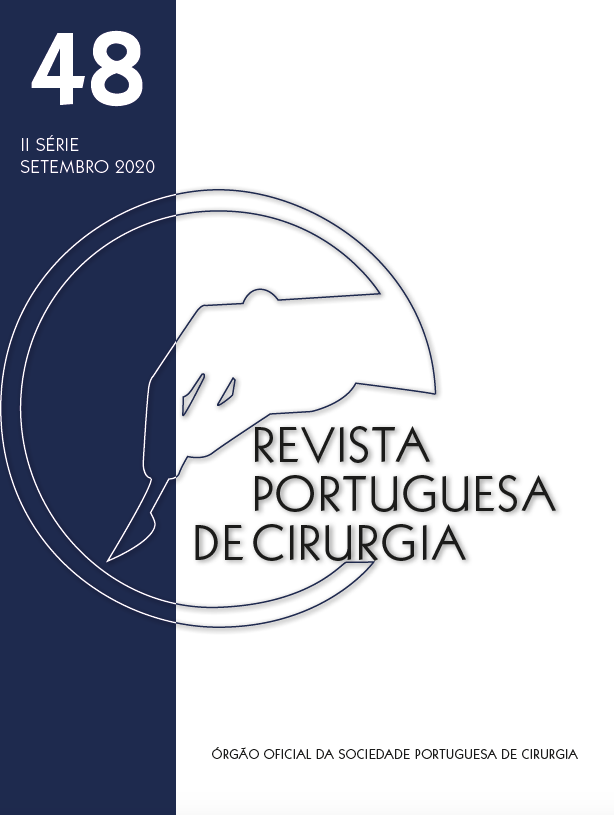RECURRENCE PATTERN IN PATIENTS WITH ADC, SIEWERT TYPES I AND II
DOI:
https://doi.org/10.34635/rpc.780Keywords:
Siewert classification, esophagectomy, esophagogastric junction, thoracic lymphadenectomy, local recurrenceAbstract
Aim: This study sought to determine the recurrence pattern of adenocarcinoma of the esophagogastric junction (AEG) after radical resection.
Patients and Methods: We retrospectively analyzed the clinical database that was propectively updated of 108 consecutive patients with Siewert type I, I/II, and II AEGs who underwent curative resection (R0) at the Institute of Portuguese Oncology in Lisbon.
Results: Recurrence occurred in 20 patients, most of them in type I / II tumors. The median time to recurrence detection was 12 months. We found locoregional recurrences in only 4 patients.
Conclusion: The surgical approach and respective lymphadenectomy used for type I, I / II and II tumours seems appropriate, since the reported local recurrence rate is low (3,7%.).
Downloads
References
2. Pohl H, Welch HG. The role of overdiagnosis and reclassification in the marked increase of esophageal adenocarcinoma incidence. J Natl Cancer Inst. 2005; 97: 142-146
3. Kusano C, Gotoda T, Khor CJ, Katai H, Kato H, Taniguchi H, Shimoda T. Changing trends in proportion of adenocarcinoma of the esophagogastric junction in a large tertiary referral center in Japan. J Gastroenterol Hepatol. 2008;23:1662–1665
4. Blaser MJ, Saito D. Trends in reported adenocarcinomas of the oesophagus and gastric cardia in Japan. Eur J Gastroenterol Hepatol. 2002;14:107–113
5. Hölscher AH, Siewert JR, Bottcher K, et al. Surgical Classification for Adenocarcinomas of the Gastroesophageal Junction. In: Siewert J.R., Hölscher A.H. (eds) Diseases of the Esophagus. Springer, Berlin, Heidelberg. 1988
6. Reeh M, Mina S, Bockhorn M, et al.: Staging and outcome depending on surgical treatment in adenocarcinomas of the oesophagogastric junction. Br J Surg 2012; 99:1406–1414
7. Van Hagen van Hagen P, Hulshof MCCM, van Lanschot JJB, et al. Preoperative Chemoradiotherapy for Esophageal or Junctional Cancer. N Engl J Med 2012;366:2074-84
8. Cunningham D, Allum WH, Stenning SP, Thompson JN, Van de Delde CJ, Nicolson M, Scarffe JH, Lofts FJ, Iveson TJ, Smith DB, Langley RE, Verma M, Weeden S, Chua YJ; MAGIC Trial Participants. Perioperative chemotherapy versus surgery alone for ressectable gastroesophageal cancer. N Engl J Med. 2006;355(1):11-20
9. Bumm R, Wong J. More or less surgery for esophageal cancer: extent of lymphadenectomy in esophagectomy for squamous cell esophageal carcinoma: How much is necessary? Dis. Esoph. 1994;7:151–155
10. Mariette, C., Piessen, G., Briez, N., Gronnier, C., & Triboulet, J. P. (2011). Oesophagogastric junction adenocarcinoma: which therapeutic approach? The Lancet Oncology, 12(3), 296–305.
11. Japanese classification of gastric carcinoma: 3rd English edition. Gastric Cancer (2011) 14:101–112
12. Haverkamp L, Seesing M.F.J, Ruurda J.P, Boone J, v. Hillegersberg R. Worldwide trends in surgical techniques in the treatment of esophageal and gastroesophageal junction cancer. Diseases of Esophagus 2017; 30: 1-7
13. Tajima Y, Yamazaki K, Makino R, Nishino N, Masuda Y, Aok S, Kato M, Morohara K, Kusano M. Differences in the histological findings, phenotypic marker expressions and genetic alterations between adenocarcinoma of the gastric cardia and distal stomach. Br J Cancer 2007;96:631-8.
14. Li-Chang HH, Kasaian K, Ng Y, Lum A, Kong E. Lim H, Jones SJ, Huntsman DG, Schaeffer DF, Yip S. Retrospective review using targeted deep sequencing reveals mutational diferences between gastroesophageal junction and gastric carcinomas. BMC Cancer 2015; 15:32.
15. American Joint Committee on Cancer (AJCC) TNM Staging Classification for Carcinoma of the Stomach (7th Edition – 2010). AJCC Staging Manual 7th Edition, 2010.
16. Nishi MKT, Akune T, et al. Cardia cancer-proposal of cancer in the esophagogastric junction (in Japanese). Geka Shinryo (Surg Diagn Treat). 1973;15:1328–38.
17. Berlth F, Hoelscher AH. History of esopaghogastric junction cancer treatment and current surgical management in western countries. Journal of Gastric Cancer. 2019;19(2):139-147
18. American Joint Committee on Cancer (AJCC) TNM Staging Classification for Carcinoma of the Esophagus and Esophagogastric Junction (8th Edition – 201). AJCC Staging Manual 7th Edition, 2017.
19. Zhang S, Orita H, Fukunaga T. Current surgical treatment of esophagogastric junction adenocarcinoma. WJGO 2019; 11(8): 567-578
20. Nobel T, Molena D. Surgical principles for optimal treatment of esophagogastric junction adenocarcinoma. AGSurg. 2019;3:390-395
21. Curtis NJ, Noble F, Bailey IS, Kelly JJ, Byrne JP, Underwood TJ. The relevance of the Siewert classification in the era of multimodal therapy for adenocarcinoma of the gastro-oesophageal junction. J Surg Oncol. 2014;109(3):202-7.
22. Siewert JR, Feith M, Werner M, Stein HJ. Adenocarcinoma of the esophagogastric junction: results of surgical therapy based on anatomical/topographic classification in 1002 consecutive patients. Ann Surg 2000; 232: 353–61.
23. Feith M, Stein HJ, Siewert JR. Adenocarcinoma of the esophagogastric junction: surgical therapy based on 1602 consecutive resected patients. Surg Oncol Clin N Am 2006; 15: 751–64
24. Hosokawa Y, Kinoshita T, Konishi M, et al. Recurrence patterns of esophagogastric junction adenocarcinoma according to Siewert’s classification after radical resection. Anticancer Res. 2014;34:4391–7
25. Kurokawa Y, Hiki N, Yoshikawa T, Kishi K, Ito Y, Ohi M, Wada N, Takiguchi S, Mine S, Hasegawa S, Matsuda T, Takeuchi H. Mediastinal Lymph node metastasis and recurrence in adenocarcinoma of esophagogastric junction. Esophagus Surgery. 2015;157;551-555
Downloads
Published
Issue
Section
License
Para permitir ao editor a disseminação do trabalho do(s) autor(es) na sua máxima extensão, o(s) autor(es) deverá(ão) assinar uma Declaração de Cedência dos Direitos de Propriedade (Copyright). O acordo de transferência, (Transfer Agreement), transfere a propriedade do artigo do(s) autor(es) para a Sociedade Portuguesa de Cirurgia.
Se o artigo contiver extractos (incluindo ilustrações) de, ou for baseado no todo ou em parte em outros trabalhos com copyright (incluindo, para evitar dúvidas, material de fontes online ou de intranet), o(s) autor(es) tem(êm) de obter, dos proprietários dos respectivos copyrights, autorização escrita para reprodução desses extractos do(s) artigo(s) em todos os territórios e edições e em todos os meios de expressão e línguas. Todas os formulários de autorização devem ser fornecidos aos editores quando da entrega do artigo.



